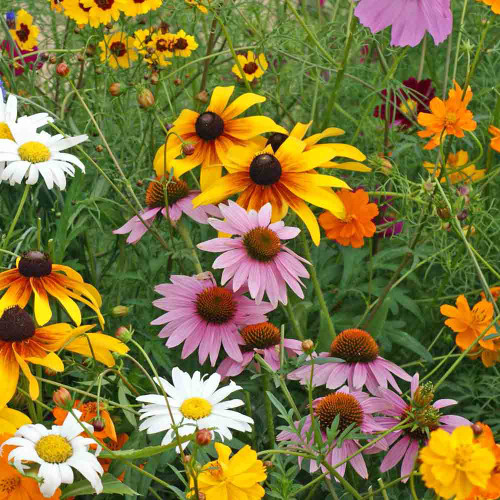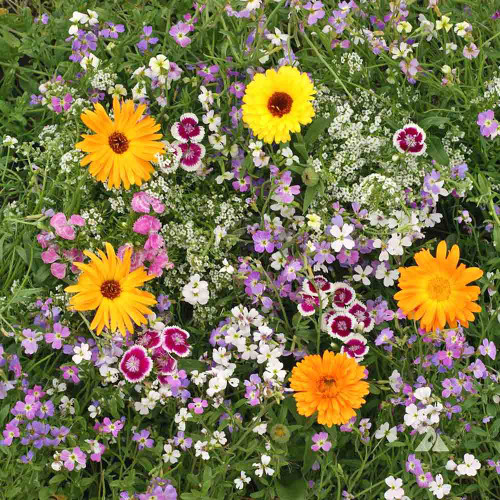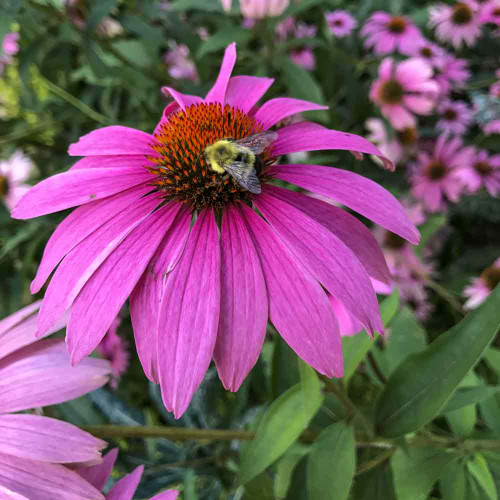Description
Native Flower Seed Mix for Monarchs - Beauty That Feeds Our Beloved Butterflies
Creating a welcoming space for Monarch butterflies starts with the critical gift of milkweed, the sole nursery for their young. But a complete Monarch sanctuary offers more – it provides for their entire lifecycle. As we've expanded our milkweed offerings and talked with passionate gardeners, the need for a comprehensive habitat solution became clear. Many of you asked what to plant alongside milkweed to fully support the adult butterflies with the vital nectar they need for flight, reproduction, and their awe-inspiring migration.
Our Native Flower Seed Mix for Monarchs is our answer. This thoughtfully chosen blend of native wildflowers, including annuals, perennials, and crucial milkweeds, is designed to provide that complete support system. It ensures a succession of blooms from summer through fall, offering a reliable and diverse nectar source that turns your garden into a life-sustaining haven for these cherished visitors.
Details
Our Native Flower Seed Mix for Monarchs is curated to create a vibrant, evolving habitat that offers comprehensive support for Monarch butterflies, while also attracting a diverse array of other beneficial pollinators to enrich your garden. This diverse blend includes a strategic mix of annuals for first-year color and perennial wildflowers that establish for long-term beauty and ecological function. Expect a dynamic display with plants ranging in height, creating varied layers that bloom in succession from early summer often through the first frosts of fall. This mix is designed to thrive in full sun (6+ hours daily) and performs best in average, well-drained soil. One seed packet will generously plant approximately 16 square feet (a 4x4 foot space).
Your Monarch Sanctuary
Your garden becomes a sanctuary for Monarchs with this seed mix that provides the essential elements Monarchs need to thrive, from vital host plants for their caterpillars to crucial nectar sources for migrating adults. It's a direct way for home gardeners to contribute to Monarch conservation and witness their fascinating life cycle up close.
While this carefully selected mix contains 19 beneficial native species, several play starring roles in supporting Monarchs. Essential Swamp Milkweed (Asclepias incarnata) and Butterfly Milkweed (Asclepias tuberosa) serve as the exclusive host plants Monarch caterpillars depend on for survival; they are the only plants that caterpillars can eat.
Adult Monarchs depend on nectar for food, and Purple Coneflower (Echinacea purpurea) offers a mid-season feast, while late-blooming powerhouses like New England Aster (Symphyotrichum novae-angliae) and Rigid Goldenrod (Solidago rigida) provide critical fuel for migrating Monarchs and nourishment for other pollinators preparing for winter.
Beyond Monarchs, this mix is a powerhouse for attracting a wide array of other butterflies, bees, and hummingbirds. It also provides habitat and resources for beneficial predatory insects, contributing to a healthier, more balanced garden ecosystem. Once established, this planting will become a low-maintenance source of beauty and vibrant ecological activity.
What's In Your Monarch Mix?
This mix contains the following 19 native species, each selected for its value to Monarchs, pollinators, and a healthy garden:
- Bergamot (Monarda fistulosa)
- Swamp Milkweed (Asclepias incarnata)
- Butterfly Milkweed (Asclepias tuberosa)
- Smooth Aster (Symphyotrichum laeve) (formerly Aster laevis)
- New England Aster (Symphyotrichum novae-angliae) (formerly Aster novae-angliae)
- Tickseed Sunflower (Bidens aristosa)
- Lance-Leaved Coreopsis (Coreopsis lanceolata)
- Purple Coneflower (Echinacea purpurea)
- Joe Pye Weed (Eutrochium maculatum) (formerly Eupatorium maculatum)
- Indian Blanket (Gaillardia pulchella)
- Wild Sunflower (Helianthus annuus)
- Ox-Eye Sunflower (Heliopsis helianthoides)
- Gayfeather (Liatris spicata)
- Clasping Coneflower (Rudbeckia amplexicaulis)
- Cutleaf Coneflower (Rudbeckia laciniata)
- Compass Plant (Silphium laciniatum)
- Rigid Goldenrod (Solidago rigida)
- Hoary Vervain (Verbena stricta)
- Prairie Ironweed (Vernonia fasciculata)
Planting and Growing Tips
Establishing a thriving Monarch haven from seed is a rewarding process that begins with good preparation. Choose a site that receives at least 6-8 hours of full sun daily. While many natives are adaptable, they generally prefer average, well-drained soil. Avoid overly rich or heavily amended soils, as many wildflowers thrive in leaner conditions.
While ideal for creating ground-level sanctuaries, portions of this diverse mix can also be successfully grown in large containers (e.g., half-barrels or planters at least 15-20 gallons deep and wide) with excellent drainage. Select a sunny spot, use good quality potting mix, and be mindful that container plantings will require more consistent watering than in-ground beds. You'll create a beautiful, compact pollinator oasis!
Sowing Your Seeds: The best times to sow are often fall (dormant seeding) for natural cold stratification, or spring anytime after frost danger and when soil reaches at least 55°F. Mix the fine seeds with an inert carrier like sand (4:1 ratio) for more even distribution. Broadcast half the mix walking in one direction, and the other half walking perpendicularly. Sow on the surface or cover no more than 1/8 inch deep, then press the seeds firmly into the soil for good contact (walking on the area or using a light roller works well).
First Year & Beyond: Water gently but thoroughly after sowing and keep the soil consistently moist until seedlings are established (4-8 inches tall). In the first year, expect blooms primarily from the annuals while perennials focus on root growth. Manage weeds diligently, especially early on. Once established (typically by year 2 or 3), your native planting will require minimal watering (only in extreme drought) and no fertilization. An annual cutback in late fall or early spring is usually the only maintenance needed.
Learn More
From the soil to the seed to the food you eat - we'll help you grow your best garden!

















